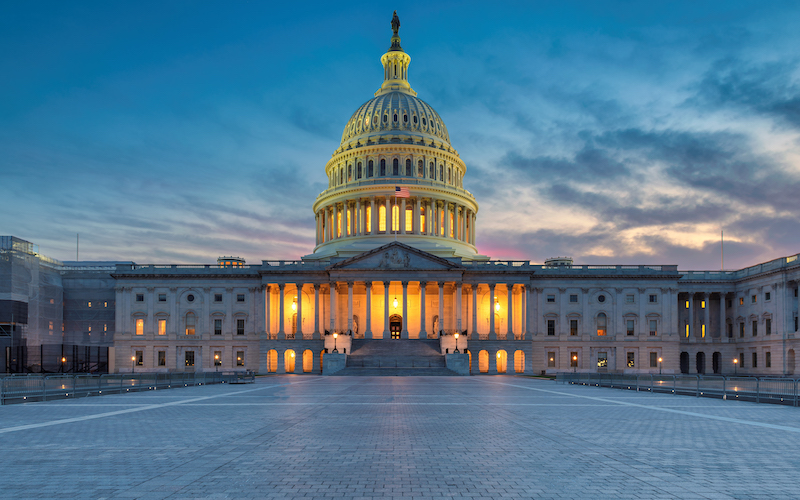
A recent Supreme Court case suggests Congress needs new processes to legislate effectively and overcome partisanship.
In Bostock v. Clayton County, the U.S. Supreme Court held 6 to 3 that the Civil Rights Act of 1964 makes it illegal for an employer to consider sexual orientation in the process of taking an adverse employment action. The majority supported that holding by arguing that any employer who takes into account sexual orientation during an action necessarily has engaged in conduct prohibited by the statute’s ban.
Most scholars will characterize Bostock as a case in which the proponents of textualism prevailed over the proponents of originalism. It certainly fits that characterization, but I want to use it to illustrate a different phenomenon. The dispute the Court resolved could—and should—have been resolved by legislative action as the public and the courts grappled with questions concerning the rights of gays and lesbians. The inability of the U.S. Congress to address the dispute through the legislative process illustrates the increasing and near complete inability of Congress to enact, amend, or repeal statutes.
The dissenting Justices accused the majority of legislating. They characterized as “preposterous” the idea that Congress intended to include sexual orientation in the definition of sex when it enacted the statute. They argued persuasively that Congress “indisputably” had no such intent and that there is “not a shred of evidence” to support the claim that Congress had such an intent. The dissenters noted that Congress had often considered, but never enacted, an amendment to the statute that would have explicitly banned consideration of sexual orientation when taking adverse employment actions.
The majority did not disagree with the dissenting Justices on most of those points. Indeed, the majority acknowledged that Congress may not have anticipated how the statute it enacted in 1964 would later be used by the majority in Bostock. The majority also explicitly acknowledged that Congress had often considered, and never enacted, proposed amendments that would have banned consideration of sexual orientation when employers take adverse employment actions. In the majority’s words: “Since 1964…Congress has considered several proposals to add sexual orientation to Title VII’s list of protected characteristics, but no such amendment has become the law.”
What none of the Justices acknowledged is the reality that almost nothing of importance becomes the law through the process of legislative action in today’s conditions. Over the past few decades, political polarization has become so extreme that it is impossible for anyone to put together the kind of bipartisan legislative compromise that used to be routine. During the Johnson and Reagan Administrations, and extending into the Clinton Administration, the President regularly met with the leaders of the opposing party in Congress to negotiate a compromise that both parties could support and that Congress could enact.
The majority opinion in Bostock illustrates the kind of compromises that could have produced an amendment to the Civil Rights Act to add sexual orientation as a protected characteristic. The majority rejected the argument that discrimination based on sexual orientation should be illegal only when it is the “sole or primary” cause of an adverse employment action. The majority also refused to consider the effects of its holding on access to bathrooms and locker rooms, or the relationship between its holding and the religious liberty interests of some employers. If Congress had amended the Civil Rights Act to include sexual orientation as a protected characteristic, any of those issues could have formed the basis for a compromise between the proponents and the opponents of a proposed amendment.
In an earlier time in the nation’s political history, the proponents might have been willing to acquiesce in some reduction to the scope of the right, or the burden of proving a violation of the right, in return for explicit recognition of the right. Conversely, the opponents might have been willing to acquiesce in recognition of the right if they could obtain some safeguards for employers who were concerned about access to bathrooms and locker rooms, potential adverse effects on employers affiliated with religions, or adverse effects on employers who inadvertently or unconsciously considered sexual orientation in taking adverse employment actions.
Political polarity has essentially eliminated the possibility of taking legislative action through the process of bipartisan compromise today. Political scientists have identified many of the causes of our extreme and growing political polarity, but no one has yet identified any promising means of reversing the trend. We may have to live with extreme political polarity for the foreseeable future, but we can take actions that reduce its adverse effects on the legislative process.
The methods we use to choose candidates for office and leaders of the U.S. House of Representatives and the U.S. Senate magnify the power of the members of both political parties who have views that lie on the extreme right or left of the political spectrum. In most cases, we rely on party-based primaries to choose candidates for office. Party-based primaries maximize the adverse effects of political polarity on Congress’s performance. They are low turnout elections that consist disproportionately of highly partisan voters who support candidates with extreme views. This process favors candidates whose views lie at the ideological extremes of their parties.
Reliance on party-based primaries also deters members of the House and Senate from engaging in the compromises that are essential to gaining support from a bipartisan majority for a proposed statute. A large majority of the seats in the House and the Senate are “safe seats,” in the sense that the incumbent’s party is virtually certain to win all general elections for the foreseeable future. Those seats are not, however, “safe” in the context of a party-based primary.
The only realistic political risk that most members of the House and Senate face is the risk of losing a primary. For Republicans, that risk comes mainly from the right. For Democrats, it comes mainly from the left. Representatives who move toward the center to compromise on a bill risk losing a primary to a candidate with more polarized views. The only way that incumbents can protect themselves from being “primaried” out of office is to take extreme partisan positions and to avoid all compromises.
Members of the House and Senate must be willing to compromise to enact bipartisan legislation. In today’s conditions of extreme political polarity, it is difficult to secure a bipartisan majority to enact a statute that has been developed through the process of compromise. If we want to return to a political environment in which a bipartisan coalition of members of Congress can enact, amend, or repeal legislation, we must identify and implement an alternative to party-based primaries.
The two most promising alternatives are the peer-based systems that most democracies use to choose candidates for office, and the nonpartisan primaries that some states are now using. Either of those alternatives is far more likely to produce candidates whose views are closer to the center of their party. Either approach would also produce members of the House and Senate who are far more willing to negotiate the compromises that are essential to successful enactment of statutes because members would not be in constant fear that they would be “primaried” out of office by more extreme and less compromising candidates.
We also choose the leaders of the House and Senate through methods that maximize the adverse effects of political polarity on the legislative process. For example, the leaders of both houses of Congress regularly refuse to allow the members to vote on legislation that a majority of the House or Senate and a majority of the general public support. They have no choice but to engage in that undemocratic pattern of conduct because they are elected by a majority of the members of their party.
For instance, if Republicans controlled 51 Senate seats, 26 Republicans could effectively block a vote on a bill that would pass on the Senate floor by a vote of 74 to 26. Similarly, if Democrats controlled 218 seats in the House—a simple majority—110 House Democrats could prevent a vote on a bill they oppose, even if the rest of the chamber supported the bill. Congressional leaders know that they risk losing their leadership positions if they anger the members of their party by allowing a vote on a statute that a majority of their party opposes.
We can eliminate this undemocratic roadblock to legislation by requiring a two-thirds vote by each house of Congress to elect its leader. Such a leader would have an incentive to allow members to vote on any bill that has the support of a majority of the members of the House and Senate and—presumptively—of the public.
We cannot survive as a nation unless we take the steps necessary to restore the power of Congress to legislate. The leaders of both parties and the members of the House and Senate can restore that power if they have the courage necessary to change the methods that we use to choose candidates for office and congressional leaders.




